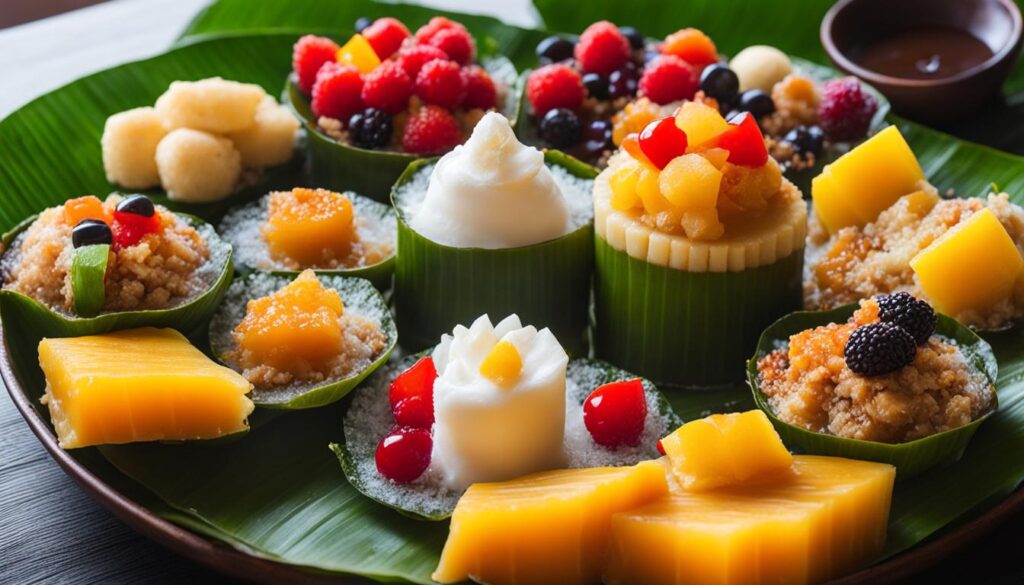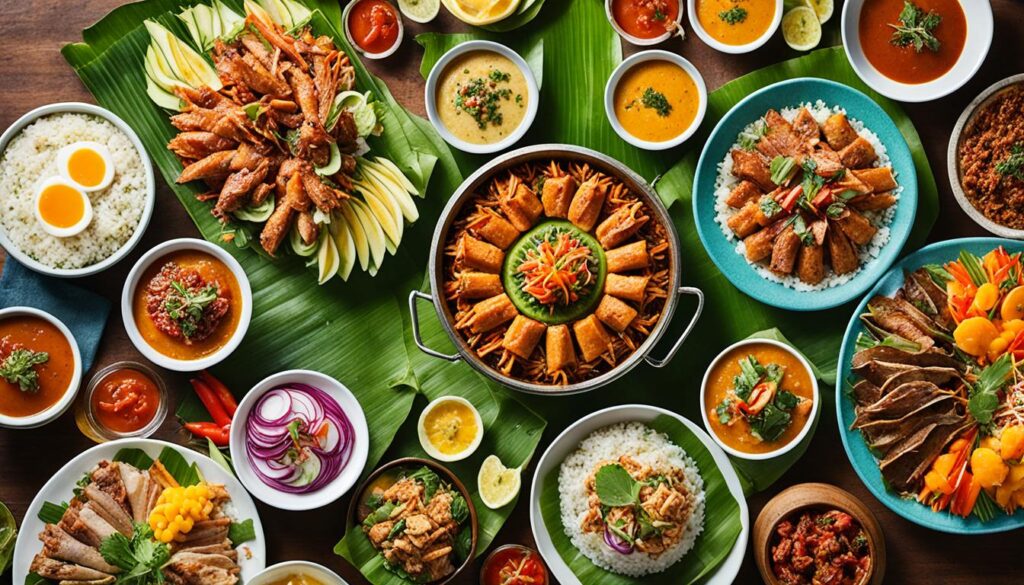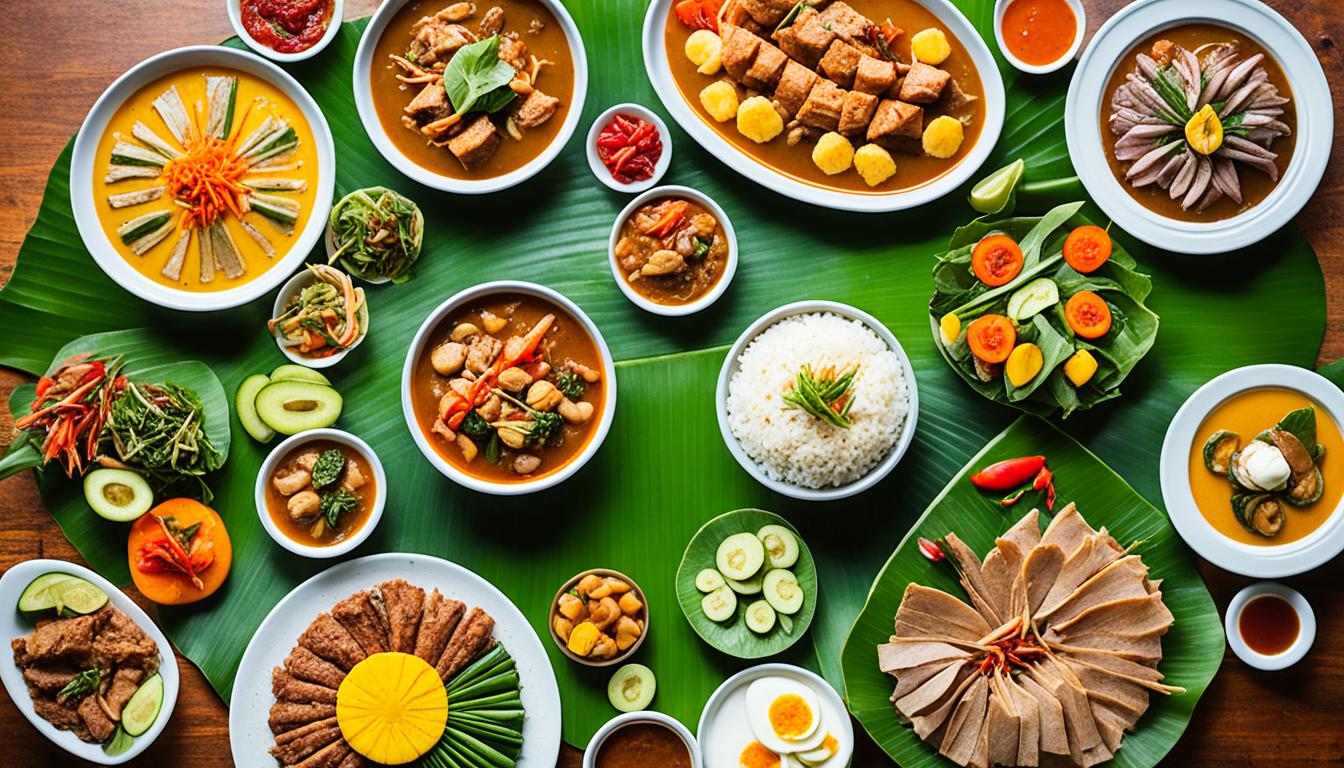Welcome to our culinary journey through authentic Filipino dishes! In this article, we will explore the rich and flavorful world of traditional Filipino cooking. From adobo to sinigang, Filipino recipes are known for their robust flavors and cultural significance. Join us as we delve into the heartwarming stories and mouthwatering recipes shared by renowned chefs, food writers, and social media stars.
This article draws inspiration from the cookbook “We Cook Filipino,” edited and compiled by Jacqueline Chio-Lauri. Featuring 36 culinary trailblazers, this cookbook celebrates the essence of Filipino cuisine. It offers a collection of beloved recipes passed down through generations, highlighting the importance of food and culture in Filipino households.
With pre-orders now available and shipping starting on October 24, 2023, “We Cook Filipino” is a gateway to discovering the wonders of Filipino cooking. It emphasizes heart-healthy recipes and techniques that maximize flavor without excessive sodium or sugars, making it a great choice for those seeking healthier alternatives.
Join us as we unravel the secrets of Filipino cuisine. From staple ingredients like rice to the comforting warmth of soups and stews, we’ll guide you through the diverse flavors and textures that make these dishes so beloved.
Stay tuned for an enlightening exploration of pulutan, the perfect snacks for social drinking sessions. We’ll also delve into fiesta food, the culinary delights inextricably linked to joyous celebrations. And of course, we can’t forget the sweet treats that complete any Filipino meal.
So prepare your taste buds and get ready to indulge in authentic Filipino recipes. Together, let’s celebrate the richness of traditional Filipino cooking and embark on a flavor-filled adventure!
Rice: The Staple of Filipino Cuisine
Rice holds a special place in Filipino culture and cuisine, serving as the foundation of nearly every meal. It represents abundance, prosperity, and togetherness, and is a testament to the country’s rich agricultural heritage. Whether it’s a simple family dinner or a festive gathering, rice is an essential component that brings people together.
In Filipino cuisine, white rice is often steamed and served plain, allowing its fluffy texture to complement and enhance the flavors of the accompanying dishes. However, rice is much more than just a side dish. It is a versatile ingredient that can be transformed into various mouthwatering creations.
Sinangag: Garlic Fried Rice
Sinangag, or garlic fried rice, is a popular way to use leftover rice. It involves sautéing cooked rice with minced garlic until it becomes fragrant and slightly crispy. The result is a flavorful and aromatic side dish that pairs well with any savory Filipino dish. Sinangag is a common feature of breakfast plates and is often served with eggs, longganisa (Filipino sausages), or tocino (sweet cured pork).
Silog: A Hearty Breakfast Choice
For a hearty Filipino breakfast, Silog is a go-to option. Silog is a combination of sinangag (garlic fried rice) and itlog (egg), hence the name “silog”. It is typically served with a protein such as tapa (marinated beef), longganisa (sausage), or tocino (pork), providing a satisfying and flavorful start to the day.
Arroz Caldo: Warmth in a Bowl
When it comes to comfort food, Arroz Caldo takes center stage. This rice porridge is often enjoyed as a light meal or a soothing remedy during cold weather or illness. Made with chicken, rice, ginger, and saffron-like seasoning called safflower, Arroz Caldo is simmered until the rice grains have softened and the flavors have melded together. With every spoonful, you’ll experience warmth and nourishment.
Rice is undoubtedly the backbone of Filipino cuisine, weaving its way into the fabric of daily life. It serves as a vessel for the flavors and stories of the Philippines, connecting generations and bringing people closer together over a shared love for food.
Soups and Stews: Warmth and Comfort in a Bowl
Soups and stews are an essential part of Filipino cuisine and are consumed year-round. They provide warmth, comfort, and a hearty meal that brings people together. Whether it’s a sour soup like sinigang or the national favorite, adobo stew, these dishes showcase the diverse flavors and ingredients of Filipino cooking.
Sinigang is a tangy and flavorful soup made with meat or fish and infused with the sour taste of ingredients like tamarind fruit, guava, or calamansi. This refreshing soup is a beloved dish that combines savory and sour flavors in perfect harmony. It’s a delightful way to enjoy the natural taste of fresh ingredients.
On the other hand, adobo is a stewing method that involves marinating meat, typically chicken or pork, in vinegar and soy sauce before cooking it low and slow. This process creates tender and juicy meat with a rich, savory flavor. Adobo is often served with steamed rice and pairs perfectly with the tangy taste of vinegar.
Dinuguan, also known as “chocolate meat,” is a unique and flavorful stew made with pork blood, vinegar, garlic, and chilis. This dark and rich dish has earned its name due to its resemblance to chocolate. Despite its unusual main ingredient, dinuguan is a popular and beloved Filipino dish that highlights the creativity and ingenuity of Filipino cuisine.
Whether it’s a hot bowl of sinigang on a rainy day or a comforting plate of adobo for a family gathering, Filipino soups and stews offer a taste of home and a comforting warmth that brings people together.
Filipino Soups and Stews
| Soup/Stew | Main Ingredients | Flavor Profile |
|---|---|---|
| Sinigang | Meat or Fish, Tamarind, Guava, or Calamansi | Tangy, Sour |
| Adobo | Chicken or Pork, Vinegar, Soy Sauce | Savory, Rich |
| Dinuguan | Pork, Pork Blood, Vinegar, Garlic, Chilis | Rich, Unique |

Pulutan: Snacks for Drinking Sessions
In the vibrant food culture of the Philippines, pulutan takes center stage as the perfect accompaniment to a round of drinks. These delightful snacks are a fusion of crunchy, salty, and fatty flavors that are meant to be shared and enjoyed with friends during drinking sessions. They provide a burst of bold flavors that complement alcoholic beverages, making them an essential part of Filipino social gatherings.
One of the most popular choices for pulutan is lumpia, deep-fried pork spring rolls that are crispy on the outside and packed with savory fillings on the inside. These delectable rolls are a crowd favorite, offering a perfect balance of textures and tastes that satisfy the palate.
Another lip-smacking option is chicharon, addictive pork cracklings that are deep-fried to a crisp perfection. These snacks are known for their crunchy texture and incredible richness, making them an irresistible indulgence during drinking sessions.
“Pulutan adds an extra layer of enjoyment to our drinking sessions. It’s the perfect way to enhance the flavors of our favorite drinks and create unforgettable moments with friends.” – John Santos, Filipino food enthusiast
For those seeking a sizzling and flavorful treat, sisig is a must-try pulutan. This iconic dish consists of chopped and grilled pork, typically seasoned with tangy calamansi juice and spicy chili peppers. Served on a sizzling hot plate, sisig is a mouthwatering delight that captures the essence of Filipino cooking.
In addition to these classic choices, longganisa takes the pulutan experience to the next level. These sweet or savory sausages are bursting with flavors, each bite offering a delightful combination of spices and juicy meat. They add a unique twist to the drinking session, tantalizing the taste buds with their distinct taste.
Pulutan not only satisfies cravings but also embodies the spirit of camaraderie and celebration. It brings people together, creating memorable moments that are full of laughter, conversation, and shared enjoyment. Whether it’s a night out with friends or a festive gathering, pulutan is the ultimate companion for a great time.
| Pulutan Snacks | Description |
|---|---|
| Lumpia | Deep-fried pork spring rolls, crispy on the outside and flavorful on the inside |
| Chicharon | Addictive pork cracklings, fried to perfection for a crunchy texture |
| Sisig | Chopped and grilled pork seasoned with calamansi juice and chili peppers, served sizzling hot |
| Longganisa | Sweet or savory sausages bursting with flavors, perfect for pairing with drinks |
Pulutan is a testament to the rich culinary heritage of the Philippines. These snacks embody the vibrant flavors and communal spirit of Filipino food culture. So, the next time you gather with friends for a drinking session, remember to savor the best filipino dishes and the Filipino cooking techniques that make pulutan a cherished part of Filipino cuisine.
Fiesta Food: Celebration on a Plate
Fiesta food refers to dishes that are commonly prepared and enjoyed during special occasions and celebrations in the Philippines. These vibrant and flavorful dishes embody the rich culinary traditions of Filipino cuisine and bring communities together in joyful feasts.
“Filipino fiestas are a time for celebration, and our traditional dishes play a central role in these festive gatherings. From savory curries to succulent roasted meats, fiesta food represents the best of Filipino cuisine,” says Chef Maria Santos, a renowned Filipino chef.
One iconic fiesta dish is kare-kare, a Filipino curry made with tender oxtail and tripe. The dish is stewed in a rich and creamy peanut sauce, flavored with bagoong (a fermented shrimp paste), and served with a side of blanched vegetables. The combination of flavors and textures makes kare-kare a favorite among Filipinos during fiestas.

“Lechon, the centerpiece of every fiesta, is a whole roasted pig that exudes mouthwatering aromas and boasts crispy skin. The meat is succulent and packed with flavor, making it a showstopper at any celebration,” shares Chef Carlos Gomez, a highly respected Filipino culinary expert.
Another beloved fiesta dish is pancit bihon, a Philippine stir-fried noodle dish. It features thin rice noodles cooked with soy sauce, aromatics, and an assortment of vegetables and meats. Pancit bihon represents longevity and good luck and is a staple dish on birthdays and other special occasions in Filipino households.
Popular Fiesta Dishes:
| Dish | Description |
|---|---|
| Kare-kare | A savory curry made with oxtail and tripe, simmered in a peanut sauce and served with blanched vegetables. |
| Lechon | A whole roasted pig with crispy skin and succulent meat, often the star of fiesta feasts. |
| Pancit Bihon | A stir-fried noodle dish made with rice noodles, soy sauce, vegetables, and meats. |
| Adobo with Chicken Livers | A popular variation of the classic adobo dish, featuring chicken livers for added richness and flavor. |
| Roast Pork Belly with “Lechon” Sauce | Crispy roasted pork belly served with a tangy and savory “lechon” sauce. |
These diverse dishes are a testament to the cultural heritage and culinary excellence of the Philippines. Whether it’s a small family gathering or a grand community celebration, fiesta food brings people together to share delicious meals and create lasting memories.
Sweets: End Your Meal with a Sweet Treat
Filipino cuisine is renowned for its delightful array of sweet treats and desserts that bring a perfect conclusion to any meal. From traditional favorites to innovative creations, Filipino desserts offer a world of flavors and textures that satisfy any sweet tooth. Indulge in the richness of these delectable treats and experience the magic of Filipino cooking techniques.
1. Pan de Sal
One beloved Filipino dessert is Pan de Sal, a sweet Filipino-style roll that is enjoyed on its own or paired with various spreads. Soft and fluffy on the inside with a slightly crisp exterior, Pan de Sal is a staple in Filipino households and bakeries. It is often enjoyed fresh out of the oven and is perfect for breakfast or as an afternoon snack.
2. Rice Cakes (Kakanin)
Kakanin, or rice cakes, are another highlight of Filipino desserts. Made from glutinous rice, these cakes come in various shapes, sizes, and flavors. They are often flavored with coconut and sugar and have a unique chewy texture. Some popular kakanin include palitaw (rice cake topped with coconut and sugar), bibingka (rice cake cooked with salted eggs and coconut milk), and biko (sweet sticky rice cake).
3. Turon
Turon is a delightful Filipino dessert that combines the sweetness of bananas with the crispness of spring roll wrappers. This deep-fried banana spring roll is often served with a drizzle of caramel sauce or a sprinkle of sugar. The combination of the warm, sweet banana filling and the crunchy outer layer creates a delightful contrast of flavors and textures.
4. Halo-Halo
No discussion of Filipino desserts would be complete without mentioning Halo-Halo. This colorful and refreshing shaved ice dessert is a beloved Filipino favorite, especially during the hot summer months. Halo-Halo is a delightful medley of crushed ice, various sweet ingredients like beans, jellies, fruits, and a generous amount of evaporated milk. It’s a unique dessert that offers a delightful mix of textures and flavors with every spoonful.
5. Leche Flan
Leche Flan, often referred to as the Filipino caramel custard, is a rich and creamy dessert that is incredibly indulgent. Made with eggs, condensed milk, and caramel syrup, this luscious custard is steamed to perfection. It has a velvety texture and a sweet caramel flavor that melts in your mouth. Leche Flan is a popular dessert during special occasions and celebrations.
These are just a few examples of the wide variety of Filipino desserts that are sure to satisfy your sweet cravings. Filipino cooking techniques and ingredients create unique flavors and textures that make these desserts truly special.
Indulge in the sweet side of Filipino cuisine and explore the world of flavors that Filipino desserts have to offer. From classic favorites to modern twists, Filipino desserts are a treat for both the eyes and the taste buds. Experience the richness and diversity of Filipino cooking techniques in every sweet bite.
Exploring the Flavors of Filipino Cuisine
Filipino cuisine is a vibrant mix of diverse cultural influences, resulting in a unique and flavor-filled culinary experience. Traditional Filipino cooking techniques have been passed down through generations, allowing us to explore the rich flavors and textures of this beloved cuisine. From savory dishes like adobo and sinigang to mouthwatering desserts like halo-halo and leche flan, Filipino recipes offer a delightful array of flavors for every palate.
When it comes to traditional Filipino cooking, techniques such as stewing, grilling, and braising are commonly used to create dishes with rich and complex flavors. These techniques are handed down from one generation to another, ensuring that the essence of Filipino cuisine is preserved. The use of aromatic spices, such as garlic, ginger, and onions, adds depth and vibrancy to the dishes.
But Filipino cuisine isn’t just about savory delights; it also boasts a wide variety of delectable desserts. Filipino dessert recipes often incorporate ingredients like rice, coconut, and tropical fruits to create mouthwatering treats that perfectly balance sweetness and texture. Whether it’s the sticky rice cake known as bibingka or the creamy caramel custard of leche flan, Filipino desserts are a true delight that shouldn’t be missed.
Exploring the flavors of Filipino cuisine is like embarking on a culinary adventure. It allows us to appreciate the diverse cultural heritage and unique combination of ingredients that make Filipino cooking so special. So whether you’re a fan of traditional dishes, interested in trying new cooking techniques, or simply have a sweet tooth, Filipino cuisine has something for everyone.
